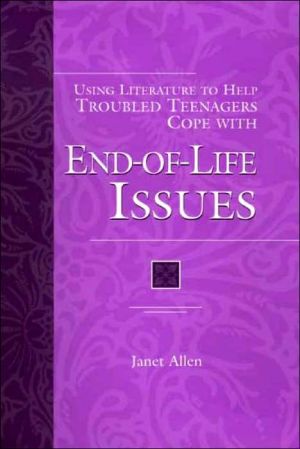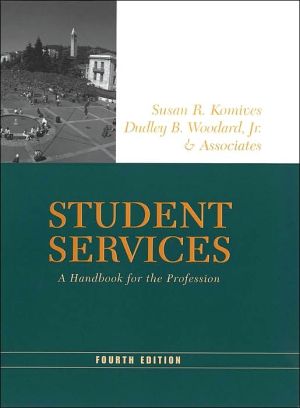Using Literature to Help Troubled Teenagers Cope with End-of-Life Issues
Losing a loved one is a scary and confusing event for teenagers, but one that can be made easier through the use of literature and informed mentoring from a caring adult. This teacher friendly reference resource and bibliography provides tools for those who work with young adults to help them come to terms with the grieving process. Literacy experts and counseling professionals are uniquely paired in each chapter to explore specific types of loss and ways in which professionals can help...
Search in google:
Use the tools provided in this reference resource to help young people come to terms with the grieving process. Jan Chapman - VOYA This book, part of a six-volume Using Literature to Help Troubled Teenagers series, provides a bibliotherapeutic focus for educators working with teens who are coping with grief and loss. The series pairs literature experts with therapists in an attempt to provide structured activities and useful bibliographies for educators assisting troubled teens. This volume addresses such topics as the death of a parent or sibling, death resulting from school violence, and teen suicide. Each chapter in the book is introduced by a poignant letter or poem from a highly recognized author, such as Sharon Draper and Ralph Fletcher, illuminating the topic being covered. The chapter goes on to focus on an analysis of a well-known work of fiction that deals with the topic and then describes structured therapeutic activities to use with teens in the classroom. At the end of each chapter is an annotated bibliography of selected books, both fiction and nonfiction. Also included with the bibliographies are lists of organizations and support groups and source notes. The book provides a wealth of information for educators hoping to provide guidance to troubled teens, but the activities are meant for a classroom setting and would not be useful to most public librarians. The annotated bibliographies, although not extensive, could be helpful in providing readers' advisory to teens coping with these issues. Large public libraries with extensive parent or teacher collections and school librarians would benefit from the purchase of this book. Index. Biblio. Source Notes. Further Reading. 2002, Greenwood, 264p. PLB
Series ForewordA Letter from Robert CormierAcknowledgmentsIntroduction: Shared Grieving and Celebration"Grey"1Ch. 1Helping Teens Cope through Sharing Their Stories about Death3A Letter from Angela Shelf Medearis23"Immune"24Ch. 2Discovering Life in Death: Confronting AIDS-Related End-of-Life Issues in It Happened to Nancy25A Letter from Paul B. Janeczko57"So Many Days"58Ch. 3Giving Words to the Grief: Using Two Moons in August, Saying It Out Loud, and Tiger Eyes to Explore the Death of a Parent61"A Steaming Bowl of Happiness" from Fig Pudding87A Letter from Ralph Fletcher88Ch. 4Making Sense of Sibling Loss: Using A Summer to Die as a Guide through the Grief Journey91A Letter from Jan Cheripko105Ch. 5The Legacies of Our Lives: Exploring the Loss of a Grandparent with A Ring of Endless Light109From Tenderness143Ch. 6Pencils, Books, and Guns: Violence Goes to School145A Letter from Sharon Draper169"Bandaids and Five-Dollar Bills"171Ch. 7The Year without Michael: Exploring Unresolved End-of-Life Issues173A Letter from Sara Holbrook189"One, Taken to Heart ... for Wendy"190Ch. 8Remembering the Good Times: Making a Life Memorable after Suicide193"Finals"211Index213About the Contributors227
\ VOYAThis book, part of a six-volume Using Literature to Help Troubled Teenagers series, provides a bibliotherapeutic focus for educators working with teens who are coping with grief and loss. The series pairs literature experts with therapists in an attempt to provide structured activities and useful bibliographies for educators assisting troubled teens. This volume addresses such topics as the death of a parent or sibling, death resulting from school violence, and teen suicide. Each chapter in the book is introduced by a poignant letter or poem from a highly recognized author, such as Sharon Draper and Ralph Fletcher, illuminating the topic being covered. The chapter goes on to focus on an analysis of a well-known work of fiction that deals with the topic and then describes structured therapeutic activities to use with teens in the classroom. At the end of each chapter is an annotated bibliography of selected books, both fiction and nonfiction. Also included with the bibliographies are lists of organizations and support groups and source notes. The book provides a wealth of information for educators hoping to provide guidance to troubled teens, but the activities are meant for a classroom setting and would not be useful to most public librarians. The annotated bibliographies, although not extensive, could be helpful in providing readers' advisory to teens coping with these issues. Large public libraries with extensive parent or teacher collections and school librarians would benefit from the purchase of this book. Index. Biblio. Source Notes. Further Reading. 2002, Greenwood, 264p. PLB \ — Jan Chapman\ \








